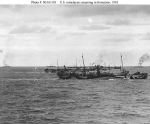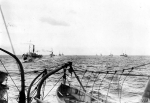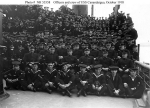NavSource Online:
Identification Numbered Vessel Photo Archive
El Siglo (ID 4510)
King - Rush - Have - Love
ex-Canandaigua (ID 1694)
George - Quack - Pup - Love |
Nan - Cast - Rush |
El Sud Class Passenger Steamer/Minelayer:
Specifications
| Commanding Officers | ||
| 01 | CDR William Herbert Reynolds, USN - USNA Class of 1897 Awarded the Navy Distinguished Service Medal (1918) - Retired as Captain | 2 March 1918 - 1919 |
| 02 | LCDR Ralph M. Packer, USNRF | 1919 - 22 September 1919 |
|
|
Assigned to Mine Squadron 1, Mine Force, Canandaigua sailed from Newport, R.I., 12 May 1918 and arrived at Inverness 6 weeks later. Participating in the laying of the gigantic North Sea Mine Barrage, she made 13 runs from Inverness, handling her hazardous duty with the precision and care required for a successful mine plant.
Following the signing of the Armistice, Canandaigua sailed for conversion to a troop transport at Boston Navy Yard, and on 11 March 1919 was assigned to the Cruiser and Transport Force. Between 8 April and 26 August, she made four voyages to France, returning some 4,800 servicemen. Canandaigua was decommissioned at New York 22 September 1919 and returned to the Shipping Board the same day.
| Back To The Main Photo Index | Back to the Identification Numbered Vessel (ID) Photo Index | Back To the Mine Warfare Ship Photo Index | Back To The Minelayer (CM) Photo Index |
| Comments, Suggestions, E-mail Webmaster |
|
This page created by Joseph M. Radigan and maintained by David Wright |




